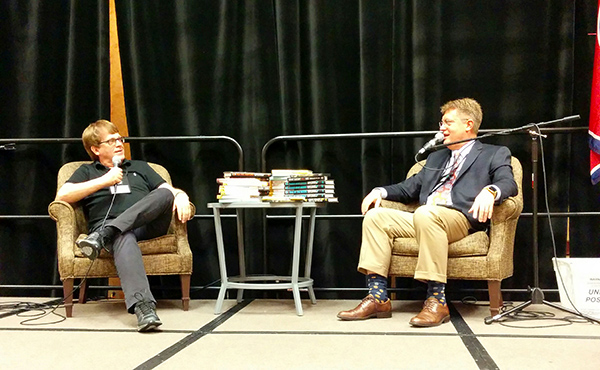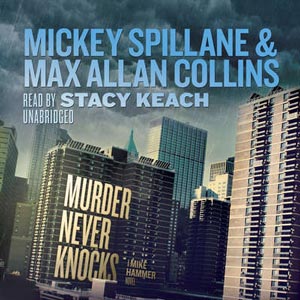If you are looking for a stocking-stuffer type gift – a book, say – you might consider Blue Christmas and Other Holiday Homicides from Wolfpack, available in trade paperback (also e-book, but I’m not sure how you stuff one of those in a stocking).
I’ve told this story before, but I’ll tell it again on the occasion of the Christmas Season. Just before Thanksgiving 1992 – right before – I received a letter from the Chicago Tribune Syndicate editor letting me go from the Dick Tracy strip after my 15 year run. Shortly thereafter Bantam cancelled Nate Heller and returned the novel Carnal Hours to me after the editor there had accepted it enthusiastically. (The previous entry, Stolen Away, had won the Best Novel “Shamus” award from the Private Eye Writers of America.)
On Christmas Eve 1992, still shellshocked, I wrote “A Wreath for Marley,” the lead story in the Blue Christmas collection. It has been published several times, including in the Otto Penzler anthology, The Big Book of Christmas Mysteries. The story is what they call (hideously) a “mash-up” – of A Christmas Carol and The Maltese Falcon. Its significance is that it showed me getting back into the game after two bad batterings. The story is a long one, probably 15,000 words, and was done in one fevered sitting. It remains my favorite short story of mine.
It almost became my second indie movie – there’s a script, you will not be surprised to learn – but the success of Mommy led to us deciding to do Mommy’s Day instead.
Anyway, on the occasion of the Christmas season, what follows is largely a rerun from 2020, but reworked with some new stuff interspersed.
Let’s start with the five great Christmas movies:
1. Scrooge (1951). Alistair Sim is the definitive Scrooge in the definitive filming of A Christmas Carol. And let’s definitely not start with the current Spirited, an overstuffed turkey that some misguided souls are already calling a Christmas classic. It has a nice premise (the story told from the ghosts’ POV) and lots of songs, most of which sound like each other, and tons of gymnastic dancing and one shaky premise blending into another (Is it about people being able to change? Or about having no friends and finding one? Is it the story of the Ghost of Christmas Past falling in unlikely love, or the story of his charge getting over himself?). As an added bonus, it goes on forever. Actually, the stars – Will Ferrell and Ryan Reynolds – have nice, funny moments now and then. But we have a candy cane of an eighty-minute movie stuffed inside a two-hour stocking full of lumped coal.
2. Miracle on 34th Street (1947). Hollywood filmmaking at its best, with Edmund Gwen the definitive, real Santa Claus, Natalie Wood in her greatest child performance, John Payne reminding us he should have been a major star, and Maureen O’Hara as a smart, strong career woman/working mother who could not be more glamorous. Beware at all costs the 1994 remake.
3. It’s a Wonderful Life (1946). Heartwarming but harrowing, this film is home to one of James Stewart’s bravest performances and happens to be Frank Capra’s best. This one got a good TV-movie, gender-reversed remake that may turn up again this year: It Happened One Christmas (1977) with Marlo Thomas and Wayne Rogers.
4. A Christmas Story (1983), Jean Shepherd’s unlikely claim to fame, and a Christmas movie with Mike Hammer and Carl Kolchak in it. Now if only the four PBS specials about Ralphie and his family would emerge on legal home video! What we have instead is a weak Christmas Story 2, a true sequel with a tragically miscast Charles Grodin in the McGavin role (A Summer Story), and this year’s A Christmas Story Christmas with the original Ralphie, Peter Billingsley, uneven but worth a watch.
5. Christmas Vacation (1989) uncovers every Christmas nightmare possible when families get together and Daddy tries too hard. This holds up very well and has unexpectedly eclipsed the original film. Its secret is nailing every real Christmas-at-home horror and taking each up a notch. And it’s easily Chevy Chase’s best performance.
Other worthwhile cinematic Christmas cheer:
Bad Santa (2003). This dark comedy has a warm heart, but you have to wade through a whole lot of black humor to get there – well worth it, though. Billy Bob Thornton is wonderful, but the late John Ritter (who apparently died during the production) has the funniest moments in a side-splitting film. Its very underrated sequel, Bad Santa 2 (2016), is perhaps even funnier with Kathy Bates almost stealing the picture playing Billy Bob Thorton’s genuinely evil mother. The original film is out there in two versions, a Director’s Cut and an Unrated Cut (well, a third version if you want the theatrical cut). Both versions are good and you might alternate them from Christmas to Christmas, year to year. The unrated cut is twelve minutes longer.
Holiday Inn (1942) is easily better than White Christmas, although the latter has its charms – it’s helped keep Danny Kaye from being forgotten, and my pal Miguel Ferrer’s mom is in it. The original is funnier and ultimately more heart-warming, though the Lincoln’s Birthday blackface number is not just tasteless, it’s one of Irving Berlin’s worst songs (“Abraham”). Shudder for a few moments, then fast-forward.
Bell, Book and Candle (1958) is an old favorite of ours, the movie Kim Novak and James Stewart made together right after Vertigo, serving as kind of an unlikely happy-ending coda to that great film. With Jack Lemmon and Ernie Kovacs bouncing beautifully off each other, it’s a precursor to Bewitched with a great George Dunning score.
The Family Man (2000) with Nic Cage, a modern reworking of It’s a Wonderful Life, is heartwarming and funny. Cage may be an over-the-top actor, but the man commits – he gives one thousand percent to every performance, and this time he has a terrific movie to do it in. There is a melancholy feel to the ending, though, as the path not taken by Cage dissolves behind him at the close, meaning some cute kids bite the imaginary dust.
The Twelve Days of Christmas (2004). This shameless reworking of Groundhog’s Day as a TV Christmas movie is funny and rewarding – good-hearted but with a darkly comic sensibility. Steven Weber is excellent as the successful slick businessman who has twelve tries to get Christmas Eve right. Molly Shannon gets her best post-SNL role. If Hallmark movies were this good, we wouldn’t be bitching about them.
Three Godfathers (1948). This John Ford western stars John Wayne and is surprisingly gritty and even harrowing before a finale that you may find too sentimental – that combination is typical Ford, though. It’s dedicated to Harry Carey and “introduces” Harry Carey, Jr., who is very good, as is Pedro Armendariz.
Prancer (1989). This features a naturalistic performance from child actor Rebecca Herrell in a smalltown/rural variation on Miracle on 34th Street. Is the reindeer the little girl helps back to health really Santa’s Prancer? Sam Elliot is uncompromising as the father who doesn’t understand his daughter, whose mother has died.
Remember the Night (1940) is the second best (after Double Indemnity) of the films Barbara Stanwyck and Fred McMurray made together. Written by Preston Sturges, it makes its humanistic points with sentiment, not sentimentality, with an occasional noir jolt.
I, the Jury (1953). On the joyous occasion of its 3-D Blu-ray/4K release, note that this much underrated first Mike Hammer movie is set at Christmas and plays off of that throughout, with holiday cards and carols the connective tissue. Biff Elliott (like the movie itself) is much underrated, and the cast is filled with wonderful character actors. The great John Alton shot it. And I am thrilled that many of the reviews of the Classic Flix limited release are giving this strong private eye film reconsideration and overdue praise.
A Christmas Horror Story (2015) features William Shatner as the comic glue (a disc jockey) holding together inter-related stories about Krampus and Christmas. There are almost as many horror movies about Christmas as there are Christmas movies, but this is one of the best in a now cluttered field. It was put together by many of the Orphan Black people.
Office Christmas Party (2016) is a very funny raunchy comedy that eventually betrays a good heart. The great cast includes Jason Bateman and Kate McKinnon. I would recommend the theatrical release, as most of the raunch included in the unrated cut isn’t particularly funny and tends not to involve any key players.
Scrooge (1970) is the second-best Christmas Carol movie. Albert Finney is wonderful as Ebenezer in this musical version, with the Leslie Briccuse score perhaps the one most like his work with Anthony Newley, who did not contribute to this score but who played Scrooge in the much-seen British stage version (which came after the film). The best song in the current Spirited (“Good Afternoon!”) is a rip-off of this film’s “Thank You Very Much.”
Arthur Christmas (2012) is a CGI cartoon with a smart, witty script. The voices in this British production include James McAvoy, Hugh Laurie, Bill Nighy and Jim Broadbent. The neglected son of Santa rises to the occasion when a toy isn’t delivered despite a state-of-the-art technologically advanced system of his favored brother’s. My seven year-old grandson Nate likes this one and so do I.
There are several special Murdoch Mysteries Christmas movies, and not all are good. But one of them is: “The Night Before Christmas” (2021), a witty Agatha Christie Old Dark House tribute. This long-running show is comfort food for Barb and me, and this example shows why we put up with the occasional clinker (to quote Ralphie’s Old Man) for the joys of most episodes.
The two Poirot/David Suchet Christmas episodes are also worth seeking out for seasonal viewing: “The Theft of the Royal Ruby” and the movie-length “Hercule Poirot’s Christmas.”
Publisher’s Weekly chose The Big Bundle as one of its “Books of the Week.”
Finally, here’s a great You Tube review of the I, the Jury disc.
M.A.C.








